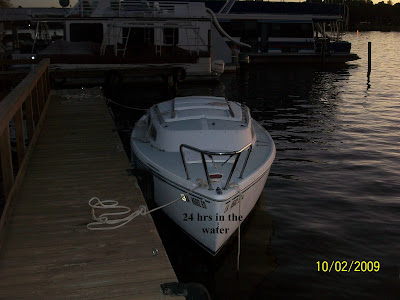




In my last entry, I laid out a plan to solve the keel problem. If you read my previous blog, you'll recall my approach to the problem : (1) decide on a plan, (2) marshal the equipment, (3)estimate manpower needs, (4)
define the objective to be achieved. I decided to use the community of sailors- both in my home state and via the internet. The equipment-The easiest and most efficient way here would be for me to make use of a 3 ton hoist. The hoist would lift the boat out of the water and set it on its trailer. Quick and simple. I had one volunteer with "hands on experience" to help me. He also arranged for my use of the hoist. Another volunteer joined in the effort. A third volunteer came forward . I turned him down because too many cooks spoil the soup. Nevertheless, I'm grateful for the abundance of help to me a veritable stranger. My objective was to get this boat home and assess the possible damage caused by the rapid release of the 550 lbs keel when the cable broke. I could only guess at the speed this piece of pig iron was travelling from the point when the cable broke. I've been told that this force could rip the keel from its bolts. And, the damage could cause a breach of the hull-the nightmare scenario for any C22 owner.
As you can see from the photos there was no hull damage. The Hoist solution worked. Kudos to the volunteer who made the hoist available. My five mile trip home was trouble free.
This problem, and its ultimate solution, remind me of the reasons why I chose to get back into boating after a ten year hiatus. The principle reason - The Catalina 22. I compare this boat to the 66 Ford Mustang. This car has been called the poor man's collector's item. This boat , with its swing keel design feature, started an excitement which brought people into the world of recreational boating. This is my second C22. The love affair persists despite my knowledge that this boat may not compare favorably with other boats in its class. There have been better 22/23 foot boats. Yet, I always remember Ann Louise. Many years have passed. Her memory remains forever fresh in my mind. She's an important reality for me to hold onto. My first C22 always brought me back home. She forgave the many nautical mistakes that I , a novice sailor, made.
A nationwide network of people came together by internet for me with articles, discussion group responses , photos, etc . This outpouring of informationwas nothing short of amazing. The C22 infatuation is still shared by many. I even received a phone call from a California owner who read about my problem in a internet discussion group.
The new keel cable is on order along with other parts of the keel raising assembly system. Lessons learned. Inspect the keel system regularly. Replace the keel cable every two years (whether it needs to be replaced or not). Know that the affection for this boat remains even after many other boat models have passed from the scene. Make use of the most valuable resource-Those owners who willingly share their knowledge. An owner, in Ohio, sent me, free of charge, spare parts. The C22 websites are legion with photos, articles, good advice, etc.The second Reason. Our sailor's passion is a tie that binds us to our common humanity most sailors feel for each other in time of need. My second volunteer. With Haiku- like wisdom expressed my feelings. At the risk of misquoting, he said" we sailors have a little knowledge about these subjects. When we pool our resources, we'll achive the best result." We appeal to the better angels of each others nature when we work together.
The cost of the repair parts will be about $100.00. The value of the lessons learned- PRICELESS.
Now, I return to the task of upgrading my mast step and plate. Stay tuned
May your boat always keep you from harm and return you home to loved ones.
Happy Sailing
Stan Best
(photos not in sequential order-sorry)

























